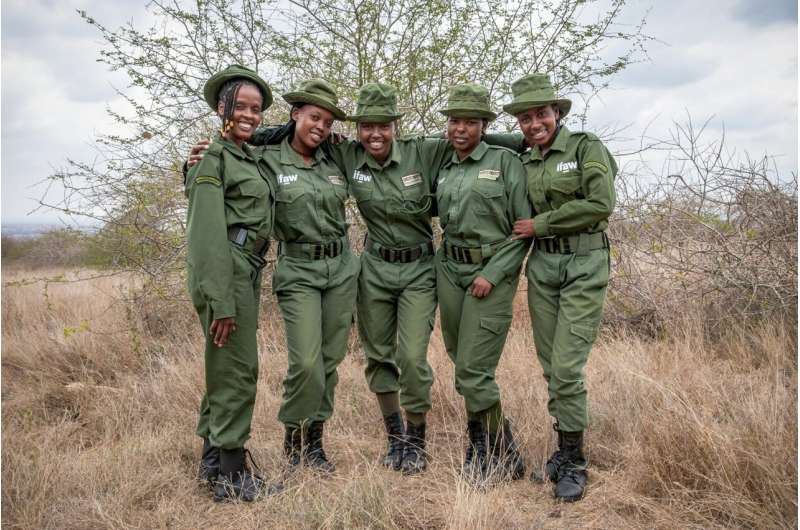This article has been reviewed according to Science X's editorial process and policies. Editors have highlighted the following attributes while ensuring the content's credibility:
fact-checked
trusted source
written by researcher(s)
proofread
Protecting wildlife begins with understanding how best to counter wildlife crimes

Global biodiversity is declining, and human activities are mainly to blame.
Every day across the world, conservation organizations, community members, conservation scientists and law enforcement authorities work tirelessly to counter this biodiversity decline. These actions can take the form of community-based patrols or enforcing regulations, such as in the case of preventing illegal harvest or patrolling efforts to deter or arrest poachers.
At the more extreme end, law enforcement officials and investigative journalists have even worked to break-up a global ring of individuals who paid to take part in the torture, and eventual murder, of baby monkeys.
These actions are broadly called counter-wildlife crime interventions.
Given the rapidly narrowing window to reverse dramatic biodiversity declines around the world, and the finite resources available to conduct conservation activities, it is important to know what types of conservation interventions work and which don't work.
Our work at the Canadian Center for Evidence-Based Conservation (CEBC)—in collaboration with staff from the United States Fish & Wildlife Service (USFWS) and colleagues with experience in wildlife crime and conservation—uses a mixture of evidence synthesis and "systematic mapping" to provide these vital insights.
Our work used a systematic mapping approach to summarize current research addressing the effectiveness of counter-wildlife crime interventions for conserving African, Asian and Latin American wildlife directly threatened by exploitation.
The effectiveness of interventions was viewed in terms of whether they could be linked to biological recovery (such as in increased abundance or biomass) or to threat reduction outcomes (such as fewer poaching incidents). Below we share our findings.
Where are counter-wildlife crime actions taking place?
From our synthesis of 530 studies, we found that most (81%) concerned Africa and Asia, with relatively fewer (13%) in Latin America. This geographical imbalance may be due, in part, to a language bias on our part, as we only considered English language articles, and not Spanish ones.
However, other studies have also noted a lack of funding and data for counter-wildlife crime investigations and interventions in Latin America.
In addition, most studies focused on the most popular and charismatic species, such as African and Asian elephants (16%) and wild cats (14%), followed by turtles and tortoises (11%).
Evaluating interventions
Put simply, the effectiveness of most counter-wildlife crime interventions have not been rigorously evaluated.
We found that around 90% of studies evaluating counter-wildlife crime interventions only measured outcomes after an intervention was implemented. This is realistic, considering the way conservation operates in the real-world with funding often providing for a short time frame to operate. However, it is also largely ineffective in determining a causal relationship.
We found several knowledge gaps that would benefit from more attention and research.
More efforts are required to understand the effectiveness of counter-wildlife crime interventions in Latin America. Additionally, we found that current research on the topic is lacking for plants, birds, and reptile species.
Moreover, research into the effectiveness of interventions that aim to protect wildlife before they are exploited, rather than interventions aimed at detecting or disrupting illegal wildlife trade, are sorely needed.
Finally, there are critical gaps in our knowledge on the outcomes of counter-wildlife crime efforts at the population and species level (for example, ultimate conservation targets such as wildlife abundance and biomass).
Why is this research needed?
Our work highlights where current research efforts have been focused. We also show where we need to direct future research attention. The bottom line is that we need to improve testing of what conservation tools are most effective.
Ask yourself, would you swallow a pill if you knew that medicine hadn't been clinically tested for safety and effectiveness? Probably not! And why should wildlife conservation be any different?
Our findings force us to confront some difficult questions about the assumptions made when investing in a counter-wildlife crime intervention. Chief among these is just how unreliable the evidence is that routinely applied interventions actually work. That is not to say that counter-wildlife crime interventions don't work, but rather that we're working off rules of thumb instead of evidence, which risks us investing in ineffective interventions.
Jen Miller, a program officer with the USFWS' Combating Wildlife Trafficking Program and a co-author on the study, said to the Canadian Center for Evidence-Based Conservation:
"These findings are invaluable feedback to donor agencies like USFWS that contribute to projects combating wildlife trafficking. This flashing red light of alarm could lead us to a transformational moment. This isn't just a call for more research—it's a wake-up call to roll out a different model of conservation, where we implement interventions while simultaneously testing their effectiveness."
Our research suggests it's time we start rigorously testing our conservation tools to ensure we're responsibly applying solutions that protect wildlife, people and the planet we all call home.
Provided by The Conversation
This article is republished from The Conversation under a Creative Commons license. Read the original article.![]()





















